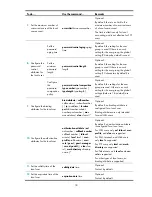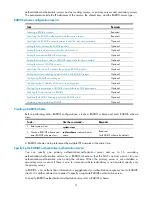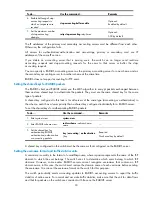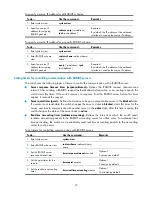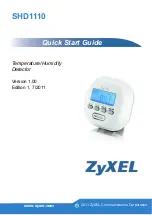
12
Number Attribute
Description
15
Login-Service
Type of the service that the user uses for login.
18 Reply-Message
Text to be displayed to the user, which can be used by the server to
indicate, for example, the reason of the authentication failure.
26 Vendor-Specific
Vendor specific attribute. A packet can contain one or more such
proprietary attributes, each of which can contain one or more sub-
attributes.
27 Session-Timeout
Maximum duration of service to be provided to the user before
termination of the session.
28 Idle-Timeout
Maximum idle time permitted for the user before termination of the
session.
31 Calling-Station-Id
User identification that the NAS sends to the server. For the LAN
access service provided by an HP device, this attribute carries the
MAC address of the user in the format HHHH-HHHH-HHHH.
32 NAS-Identifier
Identification
that the NAS uses for indicating itself.
40 Acct-Status-Type
Type of the Accounting-Request packet:
•
1—Start
•
2—Stop
•
3—Interium-Update
•
4—Reset-Charge
•
7—Accounting-On (Defined in 3GPP, the 3rd Generation
Partnership Project)
•
8—Accounting-Off (Defined in 3GPP)
•
9 to 14—Reserved for tunnel accounting
•
15—Reserved for failed
45 Acct-Authentic
Authentication method used by the user:
•
1—RADIUS
•
2—Local
•
3—Remote
60 CHAP-Challenge
CHAP challenge generated by the NAS for MD5 calculation during
CHAP authentication.
61 NAS-Port-Type
Type of the physical port of the NAS that is authenticating the user:
•
15—Ethernet
•
16—Any type of ADSL
•
17—Cable (with cable for cable TV)
•
201—VLAN
•
202—ATM
If the port is an ATM or Ethernet port and VLANs are implemented on
it, the value of this attribute is 201.
79 EAP-Message
Used for encapsulating EAP packets to allow the NAS to authenticate
dial-in users via EAP without having to understand the EAP protocol.
80
Message-
Authenticator
Used for authentication and checking of authentication packets to
prevent spoofing Access-Requests. This attribute is used when RADIUS
supports EAP authentication.





















